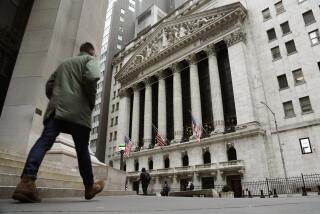CURRENCY : Dollar Ends Mixed; Gold Prices Plunge
- Share via
NEW YORK — The dollar was mixed against major currencies Friday as gold prices plunged in U.S. trading, reflecting what some analysts said was a developing deflationary attitude about the economy.
Republic National Bank of New York said gold fell to a bid $421.25 an ounce as of 4 p.m. EDT from $428.50 late Thursday.
Gold analysts said the government’s report on wholesale, or producer, prices prompted a selloff of the precious metal after the market failed to respond to what at first appeared to be a higher-than-expected increase in inflation.
“The producer price index was the source of disappointment early,” said Stephen Platt, a metals analyst with Dean Witter Reynolds Inc. “When the market couldn’t attract buying off the PPI numbers, a lot of skepticism set in about the market’s ability to hold.”
Investors traditionally have used gold as a hedge against inflation.
On the Commodity Exchange in New York, gold closed down sharply at $421.20 an ounce, compared to $428.80 late Thursday.
In earlier London trading, gold slipped to a late bid of $426.80, compared to late Thursday’s $428. In Zurich, Switzerland, gold climbed to $429.50 from $428.50.
In Hong Kong, gold edged up 4 cents to close at a bid $430.55.
Silver bullion prices rose on the London market, where the metal was trading at a late bid of $6.63 an ounce, compared to Thursday’s $6.58.
On the New York Comex, silver for current delivery fell to $6.440 from $6.612.
Prices Settled Back
Meanwhile, uncertainty gripped the foreign exchange market soon after Friday’s inflation report, traders said.
“The foreign exchange market didn’t know how to respond,” said George Palfi, vice president of foreign exchange marketing for First National Bank of Chicago.
Traders said the market rallied briefly after the report that wholesale prices rose 0.6% in August. But the market quickly settled back as it digested the numbers and found that, excluding the volatile food and energy categories, wholesale prices rose a moderate 0.3%.
The dollar usually firms on news of higher inflation because it indicates a possible rise in interest rates if the Federal Reserve moves to tighten credit. Higher interest rates in turn increase the value of dollar-denominated assets.
Last Friday, the dollar plunged on reports that unemployment had risen and the pace of production had slowed, suggesting that the economy was softening. Since then, the dollar has seesawed as investors remained undecided.
But analysts said Friday’s activity in the dollar and gold markets suggest a change in investor sentiment--that the economy is no longer booming, but slowing down.
Tables, Page 10
More to Read
Inside the business of entertainment
The Wide Shot brings you news, analysis and insights on everything from streaming wars to production — and what it all means for the future.
You may occasionally receive promotional content from the Los Angeles Times.










